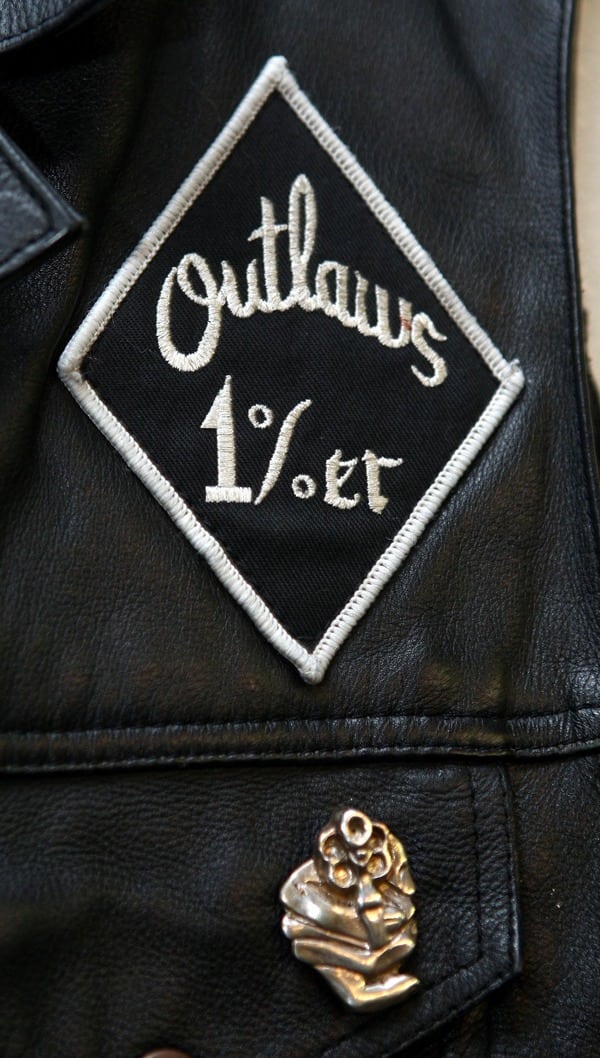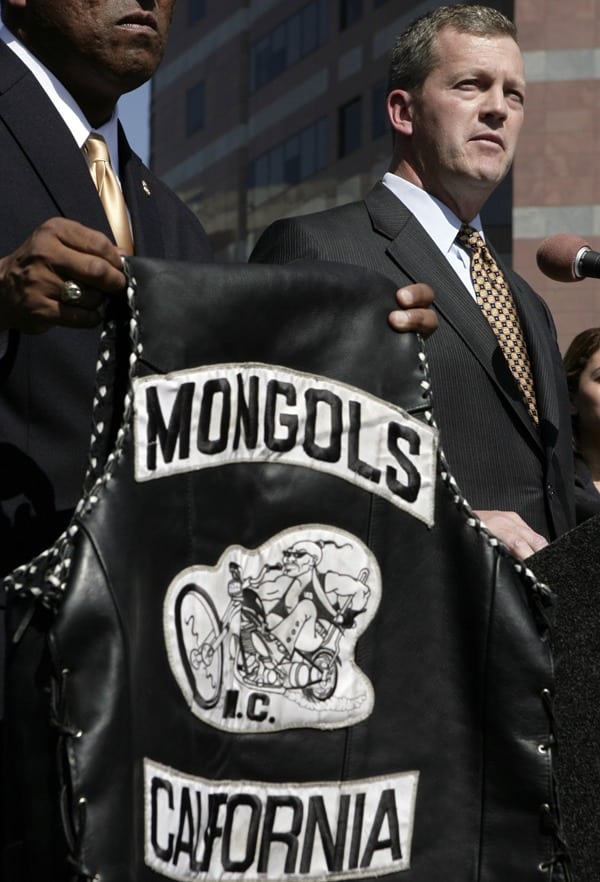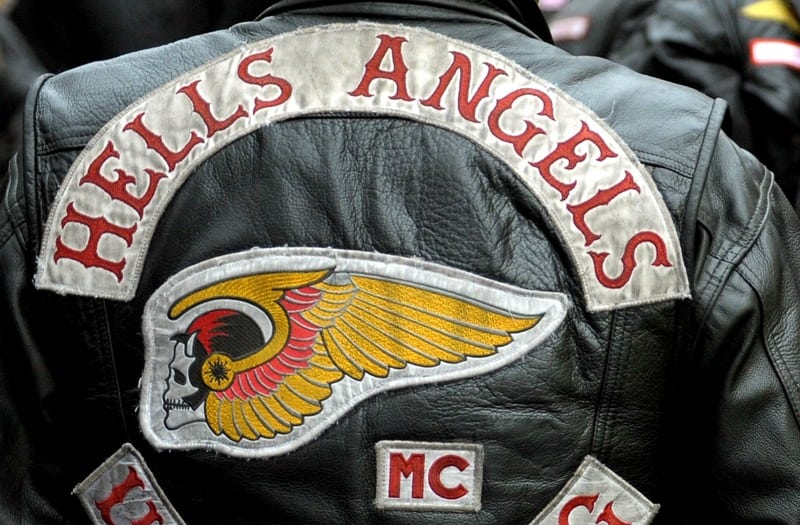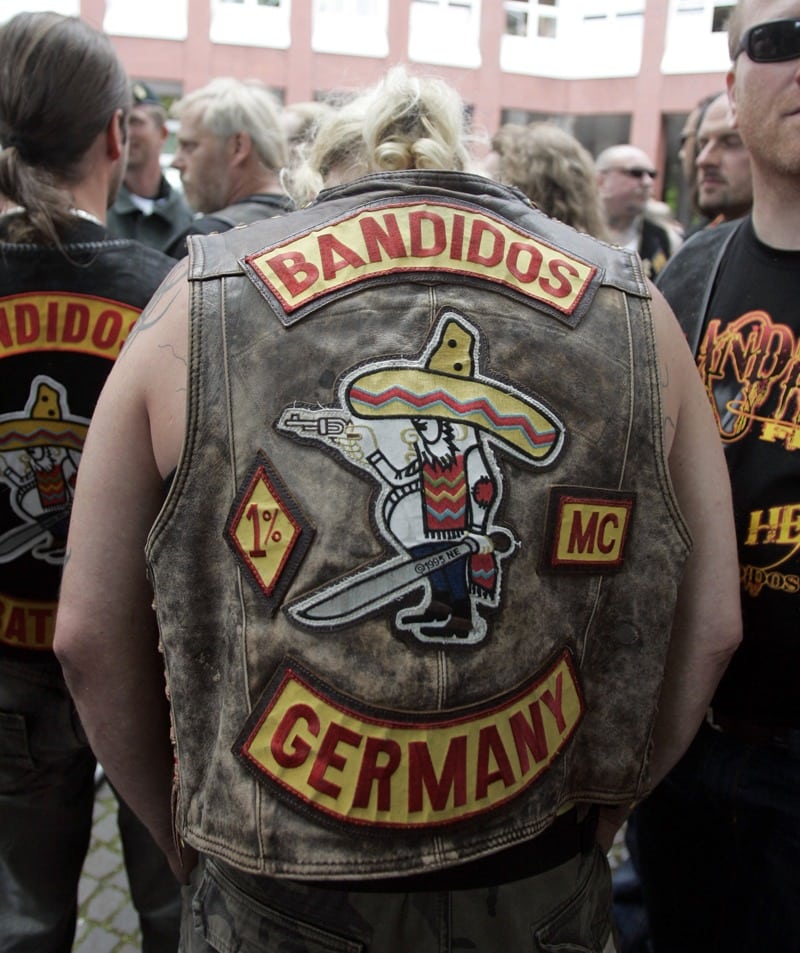| Author | Affiliation |
|---|---|
| Anand N. Bosmia, BA | Children’s of Alabama, Department of Pediatric Neurosurgery, Birmingham, Alabama |
| James F. Quinn, PhD | University of North Texas, Department of Rehabilitation, Social Work, and Addictions, Denton, Texas |
| Todd B. Peterson, MD | University of Alabama at Birmingham, Department of Emergency Medicine, Birmingham, Alabama |
| Christoph J. Griessenauer, MD | University of Alabama at Birmingham, Department of Neurosurgery, Birmingham, Alabama |
| R. Shane Tubbs, PhD, PA-C, MS | Children’s of Alabama, Department of Pediatric Neurosurgery, Birmingham, Alabama |
Introduction
Criminal hierarchy
Gang insignia
Potential for violence in the ed
Conclusion
ABSTRACT
Outlaw motorcycle gangs (OMGs) are an iconic element of the criminal landscape in the United States, the country of their origin. Members of OMGs may present to the emergency department (ED) as a result of motor vehicle accidents or interpersonal violence. When one member of an OMG is injured, other members and associates are likely to arrive in the ED to support the injured member. The extant literature for ED personnel lacks an overview of the culture of OMGs, a culture that promotes the display of unique symbols and that holds certain paraphernalia as integral to an outlaw biker’s identity and pride. The objective of this manuscript is to discuss various aspects of the culture of OMGs so that ED personnel may better understand the mentality of the outlaw biker. Knowledge of their symbols, values, and hierarchy can be crucial to maintaining order in the ED when an injured outlaw biker presents to the ED. We used standard search engines to obtain reports from law enforcement agencies and studies in academic journals on OMGs. We present the observations of 1 author who has conducted ethnographic research on outlaw bikers since the 1980s.
INTRODUCTION
The emergency department (ED) is at particularly high risk for violence against healthcare workers.1,2 The arrival of an injured gang member should cause ED personnel to become more vigilant for violent outbursts. The Gang Threat Assessment published by the National Gang Intelligence Center in November 2011 indicates that there are an estimated 1.4 million active street, prison, and outlaw motorcycle gang members in more than 33,000 gangs operating in all 50 American states, the District of Columbia, and Puerto Rico.3 Outlaw motorcycle gangs (OMGs) are an iconic element of the criminal landscape in the United States, the country of their origin. ED personnel may encounter members of these groups. The authors aim to elucidate certain aspects of the culture of OMGs so that ED personnel can better understand the mentality of the outlaw biker. OMGs present a challenge to ED personnel in that they are well organized and thus able to mobilize their members quickly to assist an injured comrade, and are often impulsive and heavily armed. These gangs have expertise in sophisticated weapons and possess an intricate intelligence network.4
Outlaw bikers refer to their organizations as “one-percenter” motorcycle clubs (MC) rather than gangs. The term “one-percenter” originated from a statement made by the American Motorcycle Association in response to a motorcycle rally held in 1947 in Hollister, California, that turned violent.5 The American Motorcycle Association stated: “99% of the motorcycling public are law-abiding; there are 1% who are not.” Thus, the “1%” patch is worn only by clubs immersed in criminality and large enough to defend the claim to be the “baddest of the bad” against all.6,7
CRIMINAL HIERARCHY
Quinn and Forsyth7 divide one-percenter clubs into 4 categories:
Support clubs, which have minor to moderate involvement with criminal activity and maintain a relationship with a larger one-percenter club for protection and to bolster their reputations (e.g., Gray Ghosts MC).
Satellite clubs, which are created and controlled by members of the larger one-percenter clubs and serve as sources of recruits to the larger clubs; members of a satellite club perform tasks related to the criminal activity of the larger club (e.g., Red Rockers MC).
Regional clubs, which have limited membership and territory (e.g., Devils Disciples MC); these groups usually have some links to larger one-percenter clubs and may or may not claim one-percenter status.
The larger one-percenter clubs (e.g., Hells Angels MC, Mongols MC, etc.) are at the top of the criminal hierarchy in the world of the outlaw biker and determine much of its dynamics.
Interclub relations are complex. Interclub affiliations may reflect a temporary alliance (primarily among large clubs) or a partial surrender of a small local club to a larger international club. While many regional clubs have surrendered their “1%” logos, these clubs retain the aggressiveness, impulsivity, and intense personal loyalties that typify the culture of the outlaw biker. Satellite clubs provide an expendable criminal labor force for the larger clubs and serve as proving grounds for men who want to join large international clubs. Furthermore, OMGs are almost entirely white in the U.S., with the exception of the largely Chicano Mongols MC. Many outlaw bikers are racists, and there are strong links between the respective cultures of outlaw bikers and white supremacists.
Black OMGs exist, but these groups operate within a different milieu and have their own symbols and values. OMGs composed of African American or mixed race members are less extreme in their entrepreneurialism and organization compared to OMGs composed of white members, and do not use the Internet as much as white OMGs do. Most black OMGs are local or regional rather than national or global in their reach, and are usually encountered on the East and West Coasts of the U.S. Many but not all black OMGs have a color scheme. For example, the California-based Chosen Few MC use red and white, but the Pennsylvania/East Coast-based Wheels of Soul MC do not appear to have a color scheme. These are the most powerful and widely known among the black OMGs. Black OMGs often use slogans, symbols, and even names of white OMGs. For example, a white OMG based in Canada and upstate New York that is loosely affiliated with the Outlaws MC also bears the name “Chosen Few MC.” Sports bikes are often used among members of black OMGs, but sports bikes are anathema to most white OMGs. While members of white OMGs in the U.S. are required to have a Harley-Davidson motorcycle, the use of Harley-Davidson motorcycles varies among black OMGs. Although black OMGs are repressed by most white OMGs, affiliations between these two groups do exist. For example, the Baltimore-based Thunderbirds MC answers to the Pagans MC.8,9
The Hells Angels, Bandidos, Mongols, Outlaws, Sons of Silence, and Pagans MCs are the most powerful OMGs.7 Statistics regarding membership for these clubs can be found at http://www.justice.gov/criminal/ocgs/gangs/motorcycle.html. ED personnel should be aware of which OMGs are active in their state of practice. The Los Angeles County Sheriff’s Department10 and the Rocky Mountain Information Network11 list which OMGs are active in each state. Because such national data are often out of date and may neglect smaller clubs, they should be supplemented with information from local authorities or the clubs’ own websites. Some of these websites provide information about smaller clubs affiliated with the larger club. However, not all clubs will have such websites (e.g., Pagans MC):
Bandidos MC: http://www.bandidosmc.com
Hells Angels MC: http://www.hells-angels.com
Outlaws MC: http://wwww.outlawsmc.com
Sons of Silence MC: http://www.sonsofsilence.com
Mongols MC: http://www.mongolsmc.com
In addition, links to the websites of major OMGs can be found at http://www.bikernews.org/wtn/news.php.
GANG INSIGNIA
Patches and tattoos reflect the sect-like symbolism of a gang’s subculture12,13 and can provide information about a gang member’s social history, such as past incarcerations, drug use, and allegiance to the gang.14 Central to the attire of outlaw bikers is the sleeveless and collarless jacket that identifies the specific club to which a biker belongs. These jackets, referred to as “colors,” are made from leather or denim.5 The patches, or “rockers,” that indicate full membership to an OMG are embroidered on a biker’s colors, and are regarded with great reverence by members and club affiliates.15 The back of a biker’s colors typically has a top rocker, which bears the club’s name; a center patch, which bears the club’s logo; and a bottom rocker, which indicates the location of the chapter of the club to which the biker belongs.5 A biker’s colors are integral to his identity as a member of the club. Should a biker’s colors be removed during the course of his care in the ED, physicians and staff would be prudent to treat his colors with respect or otherwise risk a hostile reaction from the biker and his associates.
Because there are so many OMGs active in the U.S. it would be impractical for ED personnel to memorize every specific logo or insignia associated with each one. However, the authors advise ED personnel to be familiar with the hues worn by each locally active OMG and its support and satellite clubs, and the ubiquitous “1%” patch. Most OMGs have two hues associated with their respective insignias. For example, the Hells Angels MC use red and white with their “Death’s Head” logo, whereas the Bandidos MC use red and gold with their “Fat Mexican” logo.7
Non-member associates of the club and members of support and satellite clubs often use the color scheme, but never the insignia, of the larger sponsoring club. For example, the LA Riders MC are a support club of the Bandidos MC and incorporate red and gold into their colors, which consist of a red and gold image of the state of Louisiana, but do not wear the “1%” patch or the “Fat Mexican” logo of the Bandidos MC. Only “full-patch” members may display the club logo. Full-patch members are fiendishly protective of the exclusivity of their insignia, and clubs hold copyright on their logos and other major symbols.
The “1%” logo encased in a diamond-shaped patch is worn on the front or back of the biker’s colors. Club officers have a patch listing their rank sewn onto the front breast of their colors, and some bikers will display the locations of chapters with which they have ties on the side of their colors. Some independent clubs do not wear the “1%” patch in order to avoid challenges from larger clubs, but these clubs can be just as violent as clubs who sport the “1%” patch.7 Thus, the absence of a “1%” patch does not rule out criminal ties or intense loyalties among members of the club. Knowledge of color schemes is consequently more important for recognizing members of OMGs.
Members may wear tattoos, T-shirts, and jewelry that incorporate acronyms, symbols, or logos associated with the club.16 Associates may wear “support” jewelry or T-shirts that incorporate a separate set of symbols but use the dominant club’s color scheme. For example, the logo of the Outlaws MC consists of a skull and two crossed pistons, but associates of the Outlaws MC may sport a logo that features a hand clenching a pistol, or a Harley-Davidson logo that reads “Support Black & White,” as black and white are the two main hues associated with the Outlaws MC. The process of joining a club often involves tattooing the club’s logo onto the biker’s body, and these tattoos may be displayed anywhere on the body.15 Some tattoos are immediately visible, but others will be covered by clothing or lost in a maze of body art. Any biker who is not in good standing with the club must burn off club-related tattoos, usually by heating a butter knife and applying it repeatedly onto his skin.17 Alternatively, he may have them covered with other tattoos.
Acronyms, such as “LPDP” for “Live Pagan, Die Pagan” and “AFFA” for “Angels Forever, Forever Angels,”are also prominent in the OMG culture. An acronym prevalent among OMGs is “FTW” for “Fuck the World,” an expression that has become widespread in the “saloon society” milieu in which the one-percenter culture originated. In addition, references to a specific OMG as a “nation” are also common in their written and spoken vocabulary (e.g., “Mongol Nation” for the Mongols MC or “Green Nation” for the Vagos MC).
POTENTIAL FOR VIOLENCE IN THE ED
If a gang member perceives disrespect from anyone, including ED staff, the outcome can be deadly, as gang members have an overarching requirement for respect and for saving face in all encounters and from every individual with whom they come in contact. The gang member will not hesitate to injure or kill someone if he believes that person has shown disrespect to himself or his gang.18 Power and respect are the chief values of OMGs, which are now composed of impulse-driven traditionalists and more conventional entrepreneurs. The latter are more likely to take reasoned actions within or beyond legal boundaries, but both are very capable of expressive violence.19 Most members of OMGs are a hybrid of these 2 personas. Outlaw bikers should always be treated with respect, regardless of whether their behavior warrants it.
If an injured member arrives at the ED, other members of his club will often arrive to protect him or inquire into his welfare. OMGs are an amalgam of a tribe, family, and corporation, and an ethos of “one on all, all on one” prevails, meaning that to assault or injure one member is to attack the entire club, and restoring the club’s honor is a sacred duty to which all members are bound.7 An attack on a man in 2013 illustrates the reactivity of an outlaw biker against a perceived offender. A man was alleged to have briefly argued at a bar with a member of the Sin City MC, who returned with 15 to 20 other members and attacked the man with a machete.20 Multiple news reports evidence that outlaw bikers are willing to fight with members of rival OMGs in public settings.21,22,23,24
The fact that OMGs are well-organized and primed to respond swiftly with aggression in the event of a member being injured should make ED personnel alert law enforcement with greater urgency in the event that supporters of the injured biker start to congregate at the hospital.25 As motorcyclists, their mobility aids them in evading law enforcement,16 and thus police may have a more difficult time detaining members of the club and preventing their arrival en masse at the hospital.
The cause of the biker’s injury must be clarified, as some incidents provoke immense anger from the club (e.g., a citizen ramming into a biker with a car or a biker being assaulted by members of a rival OMG), whereas others evoke only concern (e.g., a single-vehicle accident). If a biker’s injuries are secondary to interpersonal violence, the biker may avoid disclosing this fact to avoid attention. The emergency physician should take a thorough history in a non-threatening manner to improve his chances of eliciting these details from the biker and thereby avoid not anticipating dangerous complications of the biker’s injuries. For example, a fight bite is a laceration of the hand sustained by striking another individual in the mouth with a clenched fist, and such a wound can result in devastating infections if it is not treated early and correctly.26 Thus, appropriate antibiotics must be administered if a biker has sustained a fight bite.
Outlaw bikers may have weapons hidden on their persons that are discovered as their clothing is removed during the course of care. These weapons are not limited to guns and knives. Members of a specific OMG sometimes carry a particular everyday item as a weapon, the possession of which contributes to their sense of membership to the club. For example, a member of the Hells Angels MC may carry a ball-peen hammer, whereas a member of the Sons of Silence MC may sport an industrial flashlight. Emergency physicians should be particularly cautious of a biker in the ED whose colors bear a rocker reading “prospect,” “probate,” or “probationary”. A biker with such a rocker is a candidate for membership to the club and may be more prone to committing acts of aggression than a full-patch member to prove that he is worthy of membership.27 Prospective members spend 1 month to 1 year in a probationary status and are known to carry weapons for full-patch members, and some clubs have their prospective members commit felonies with full-patch members present to weed out weak candidates and curb infiltration by law enforcement.4
Women who support the club can also facilitate violence in the ED. The culture of OMGs is notoriously misogynistic, and women affiliated with these gangs are generally forced into prostitution or street-level drug trafficking.4 Women are not allowed to be members of the club, but they may wear “property” belts or vests adorned with “property” patches to indicate their affiliation with a specific club. However, female associates often do not display such insignia, which makes identifying their affiliation with an OMG more difficult. Female associates are often extremely loyal to the club and assist members with illegal activities. ED personnel should be aware that women who arrive to see an injured outlaw biker may carry weapons or drugs for the biker or members of his club.6
Rivalries among OMGs can lead to a war when 2 or more OMGs are vying for territory. If the members of rival OMG meet each other in the ED waiting room, a violent altercation is inevitable.27 Emergency physicians should inquire as to whether an outlaw biker’s injuries are secondary to a conflict with a rival OMG. If members of a rival OMG injured the biker, the biker’s adversaries may come to the hospital to finish the job.3 Although these incidents are rare, they do occur.
ED personnel must be aware that outlaw bikers do not always resemble the stereotypical “drunken, swaggering Hells Angel of 1969.” Many outlaw bikers are clean cut, and some even prefer 4-wheeled vehicles. Many OMGs consider themselves to be in a perpetual state of war with law enforcement. Thus, police officers providing security in the ED, especially if they are in uniform, may have an inflammatory effect on bikers who arrive at the hospital.
CONCLUSION
ED personnel may encounter outlaw bikers who have been injured in motor vehicle accidents or through interpersonal violence. Knowing the hues of local OMGs and their support and satellite clubs and recognizing the “1%” patch can assist ED personnel in anticipating gang-related violence. Determining the cause of the biker’s injuries is critical, as scenarios in which a biker has been injured by enemies of his club or by a citizen can predispose the biker and his associates to hostile behavior. Outlaw bikers follow a pack mentality that demands that every member support each member to the utmost.7,19 Treating these men respectfully at all times is of paramount importance to decrease the likelihood of aggression in the ED. Although OMGs share characteristics of many other types of gangs in the U.S., members sport idiosyncratic symbols that reflect the values and hierarchy of their OMG culture. Knowledge of the OMG’s symbols, values, and hierarchy can help ED personnel understand the mentality of the outlaw biker. The authors hope that this article will encourage ED personnel to conduct formal studies that focus on outlaw bikers who arrive at the ED for treatment and the outcomes of such visits.
Footnotes
Full text available through open access at http://escholarship.org/uc/uciem_westjem
Address for Correspondence: Christoph Griessenauer, MD, University of Alabama at Birmingham, Department of Neurosurgery, 1720 Second Avenue South, FOT 1062, Birmingham, AL 35294-3410. Email: cgriessenauer@uabmc.edu. 7 / 2014; 15:523 – 528
Submission history: Revision received April 9, 2013; Submitted January 20, 2014; Accepted February 21, 2014
Conflicts of Interest: By the WestJEM article submission agreement, all authors are required to disclose all affiliations, funding sources and financial or management relationships that could be perceived as potential sources of bias. The authors disclosed none.
REFERENCES
1 Strategies for managing violence against ED personnel. Physician’s Weekly Web site. ;
2 Kowalenko T Violence against ED workers a growing problem. Emergency Physicians Monthly Web site. ;
3 Moore CD Maintaining security when gang members visit your ER. Hospital, School & University Campus Safety Magazine Web site. ;
4 DeVito C . The encyclopedia of international organized crime. 2005;
5 . Quick guide to gangs. 2009;
6 Quinn JF Sex roles and hedonism among members of outlaw motorcycle clubs. Deviant Behavior. 1987; 8:47-63
7 Quinn JF, Forsyth CJ Leathers and rolexs: The symbolism and values of the motorcycle club. Deviant Behavior. 2009; 30:1-31
8 History of the Chosen Few motorcycle club. Chosen Few Motorcycle Club Web site. ;
9 Black motorcycle clubs. Black Motorcycle Clubs & Black Bike Rides Web site. ;
10 . Outlaw motorcycle gangs. 2010;
11 Gangs: Their increasing grip on the nation. A special report from rocky mountain information network. 2010;
12 Davis RH Outlaw motorcyclists: A problem for police (part 2). FBI Law Enforcement Bulletin. 1982; 51:16-22
13 Watson MJ Righteousness on two wheels. Sociological Spectrum. 1982; 2:333-349
14 Urdang M, Mallek JT, Mallon WK Tattoos and piercings: A review for the emergency department physician. West J Emerg Med. 2011; 12:393-398
15 Kemp MR Independent bikers: An ethnography of a biker community. Texas Tech University. 1989; 86
16 Riviello R . Manual of forensic emergency medicine: A guide for clinicians. 2009;
17 Lavigne Y . Hells Angels: Three can keep a secret if two are dead. 1985;
18 Allen P . Violence in the emergency department: Tools & strategies to create a violence-free ED. 2009;
19 Quinn JF, Forsyth CJ Evolving themes in the subculture of the outlaw biker. International Journal of Crime, Criminal Justice and Law. 2007; 2:143-158
20 Machete attack by “outlaw” motorcycle club sends man to hospital. ABC News Web site. ;
21 Outlaw motorcycle gangs blamed for bloody brawl at North Point flea market. CBS News Web site. ;
22 Hells Angels and Outlaws biker gangs jailed for airport riot. Telegraph Web site. ;
23 Two people suffer stab wounds after biker gang-related fight in Greeley. The Tribune Web site. ;
24 Dolan A Bikers wielded machete and meat cleaver in bout of ‘mob violence’ at airport. Daily Mail Web site. ;
25 Woodward R Law officer shot Hells Angels member in Sturgis, police say. Rapid City Journal Web site. ;
26 Roline CE, Wang S Be aware of the high risk associated with “fight bites”. Avoiding Common Errors in the Emergency Department. 2010; :1152
27 Quinn JF, Forsyth CJ The tools, tactics, and mentality of outlaw biker wars. American Journal of Criminal Justice. 2011; 36:216-230






